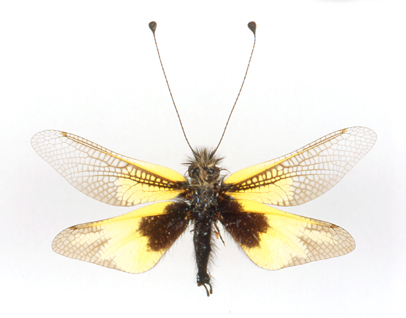Neuroptera (=Planipennia) - The Lacewings, Mantisflies, Owlflies and Antlions
A diverse and interesting order, Neuroptera contains some well-known species (like the beneficial green lacewings) but is otherwise almost totally unheard of by the layman. Perhaps best “know”, but totally misunderstood, are the doodlebugs. Doodlebugs really do exist; they are not just made-up insects that decorate childrens’ clothing and toys. While the name “doodlebug” has been given to German WWII era flying bombs as well as to self-propelled train coaches, the name really refers to the larval stage of a very interesting insect called an "antlion". Antlions have become very well known for these larvae, dubbed doodlebugs, which build conical pits in sand and dry soil. These larvae lie in wait, buried just beneath the bottom of their pit, and feed on the insects (mainly ants) which fall in. When they have reached maturity, they spin cocoons and pupate into winged adults. All Neuropterans have a larval stage that is predatory and all these larvae eventually transform into winged adults which are mostly predatory. Neuroptera is an order that still remains to be worked on by scientists. Some consider the orders Megaloptera and Raphidioptera to be a part of the Neuroptera; others consider each one a separate order. We treat them as the latter since they are a very diverse group, containing mantisflies, owlflies, spongeflies, antlions, and many kinds of lacewings. The ordinal name "Neuroptera" is derived from the Greek words for “nerve-wing” and references the extensive veining in the wings of most Neuropterans. It does not mean that they have nerves in their wings. The earliest Neuroptera fossils date back to the Permian period (225-280 million years ago) and mark Neuropterans as being the first insects to exhibit complete metamorphosis. At current, there are about 4,500 known species.


